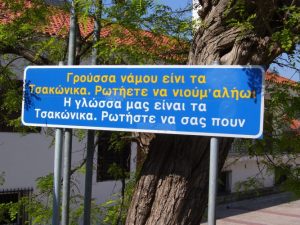The Phenomenon of Diglossia
By Sarah-Claire Jordan
 Everyone is aware that there are generally at least two languages spoken in any given country, either due to immigration or the complex linguistic history of a country. Many countries include land where originally the official language was not spoken, like the southwest of the U.S. or parts of European countries that were originally under some other rule before they became part of the current country. Bilingualism and multilingualism is nothing new to most people, but there is a very specific kind of it that only occurs in some countries and cultures. It is called diglossia.
Everyone is aware that there are generally at least two languages spoken in any given country, either due to immigration or the complex linguistic history of a country. Many countries include land where originally the official language was not spoken, like the southwest of the U.S. or parts of European countries that were originally under some other rule before they became part of the current country. Bilingualism and multilingualism is nothing new to most people, but there is a very specific kind of it that only occurs in some countries and cultures. It is called diglossia.
Diglossia is best defined as any situation where two languages or dialects are used by one language community. Generally, one of the languages or dialects is designated for everyday use, while the other is used for formal situations, like government communication, literature, and formal education. Everyone in the community knows both dialects or languages, and switches between them at the proper times.
The everyday language or dialect is sometimes referred to as the “L” or “low” variety, while the one used for formal purposes and situations is known as the “H” or “high” variety. It’s not uncommon for the high variety to be an older version of the low variety. One of the earliest examples of diglossia involves the use of Classical Latin as the high variety, and Vulgar Latin as the low.
Today, you can find diglossia in countries all over the world, from Jamaica to France and China. In Jamaica, Jamaican Creole is the low variety while English is the high variety. France has some areas where the regional language is the low language, and Standard French is the high language. In China, the same thing happens, with Mandarin being the high variety.
Besides being used only for formal situations, the high variety is usually the only one used for writing. Except in formal situations, no one ever uses the high variety in a conversation. That is what the low variety is for, for dealing with informal situations like discussions with friends, family, and neighbors.
Of course, the idea of diglossia is rather politically charged, as it can imply that the low language or variety is literally below the high language or variety. Since the high language is the one used for formal and official purposes, it can be said to have an elevated status that says “this language is better than the others spoken in this country”. This idea of diglossia being imposed by the state is known as “critical diglossia”.
That is not to say that everyone who lives in a country where diglossia occurs thinks and feels that their everyday language is somehow inferior to the formal one of their country. Sometimes it just means that one particular dialect or language is universally understood, and so it is used for more formal and official purposes, while the other language or dialect is not as well known and so remains within the community as an everyday language.
Diglossia is much more than bilingualism, though the two are definitely related, and neither of them necessarily have to do with the notion of one language being superior to the other.
For an overview of our translation expertise, visit our telephone interpreting service page
Category: Foreign Language








